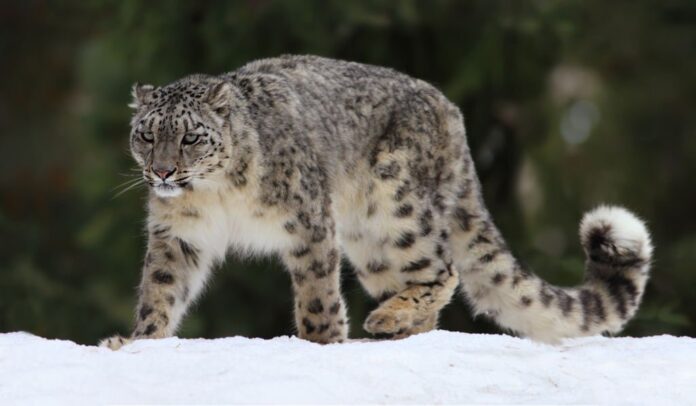KARACHI: Massive destruction and alteration of natural habitats, water dispersion, deforestation and illegal hunting and trade have taken a toll on Pakistan’s struggling wildlife over the past decade, posing serious threats to several rare species, according to experts and government officials.
Nevertheless, they said some “balancing” conservation efforts by the government and wildlife groups in collaboration with local communities have resulted in a rise in the population of several otherwise near-extinct species.
“Pakistan’s wildlife has long been under stress due to several factors, including habitat destruction, water dispersion, illegal hunting and trade and deforestation in recent years,” said Mohammad Moazzam Khan, a technical adviser to World Wide Fund for Nature (WWF) -Pakistan.
Speaking to Anadolu Agency on the occasion of World Wildlife Day falling on March 3, Khan, however, observed that there has been a “remarkable” increase in the population of several marine and land species in the country during the same period.
The country has seen an “ostensible” decrease in the number of migratory birds, wild bears, blackbucks, pangolins and Onagher (Indian asp), whereas there are some animals like leopards whose population has been reduced and increased simultaneously in different areas, according to the WWF official.
The number of snow leopards in Gilgit-Baltistan, which borders China, and the common leopard found in Punjab and Azad Jammu and Kashmir (AJK) has soared, whereas the leopard population in Sindh and Balochistan has alarmingly declined, he added.
Have been sent more videos of snow leopards taken this year. MashaAllah the numbers are increasing due to my government’s strict policy of protecting them in their natural habitat. pic.twitter.com/0OLSxgQACI
— Imran Khan (@ImranKhanPTI) December 25, 2021
Khan said the population of hogs, gavials and crocodiles has also fallen by alarming levels due to “massive” deforestation” along the Indus River, mainly in Sindh.
Mudassir Hasan, the deputy director of wildlife for Punjab, noted that “degrading “ and “shrinking” habitats due to increasing human activity and climate change have wreaked havoc on the wildlife in the province.
“Climate change has brought all natural resources including wildlife around the world under stress, and Pakistan is no exception,” Hasan told Anadolu Agency, adding the province has recorded a huge decline in the number of migratory ducks in recent years.
“Our water bodies have become polluted and are shrinking. Space for migratory birds like cranes, flamingoes, gadwalls and canvasbacks is rapidly shrinking due to pollution and the unavailability of food,” he added.
Fencing and deforestation
According to Nawaz Khuhro, a Karachi-based analyst who regularly writes on the environment and climate change, the forest cover in Sindh has been reduced to an alarming level of less than 2 percent.
The key factors behind this massive deforestation, he said, are illegal encroachment by tribal chieftains and the allotment of forest lands to politicians and landlords for farming purposes by the government.
“Over the past three decades, over 200,000 acres of forest land have either been illegally occupied or allotted by the successive governments to their favourites in Sindh alone,” he said.
Fencing of the Line of Control (LoC) — a de facto frontier that divides the Himalayan Kashmir valley between Pakistan and India — and the Thar border has shrunk the habitat for wild boars, leopards and Onagher, he added.
Sign of recovery
Khan cited huge illegal trade behind the shrinking number of pangolins due to the high demand for its meat and shells in China.
“There are some species like vultures and other rare birds which have shown signs of a recovery, but they are still endangered,” he said.
However, the populations of several species of Markhor goat, Pakistan’s national animal, the Sindh Ibex (wild goat), Balochistan Urial (wild sheep), Chinkara (deer), snow leopard and Nilgai (bluebuck) have shown an upward trajectory in recent years, contrary to predictions about their possible extinction, according to Khan.
In terms of marine species, he went on to say the number of blind Indus dolphins, all five species of marine turtles found in the Arabian Sea, and whales has seen significant growth.
Sharing a similar view, Hasan said wildlife authorities “to an extent” have managed to protect the rare Chinkara deer in the Cholistan Desert which borders India.
He said in the Potohar range, the Urial goat has been protected with the help of local communities.
“The local communities take care of Urial, and in return, the government spends 80 percent of the money it earns through the issuance of the license for hunting the four oldest goats on them every year,” he explained, adding the fee is charged in US dollars, with one Urial costing $18,000 to hunt.
Annually, 12 to 16 licenses are issued to both local and foreign hunters.
Last year, a US hunter paid a record $88,000 to bring down a Markhor in the Chitral mountains which sit on Afghanistan’s border.























